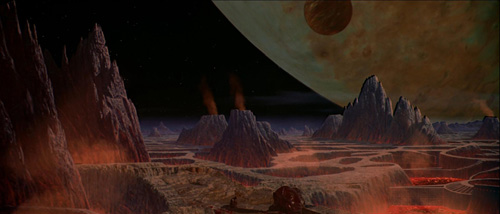40 Eridani system (Myriad)
LUG Timeline
| Affiliation | United Federation of Planets[1] |
| System Type | Trinary[2] |
| Primary Star | Name: Ko'vel[3] (40 Eridani A / Omicron 2 Ceti)[2] Spectral Class: Type K1V[3][2] (Ko'vel) Absolute Magnitude: 6.0[2] Planets: I: Class B[2] II:[2] Vulcan[4] (Class M)[1] III:[2] T'Khut[5] (Class G)[2] |
| Companion Stars | Distance from Primary: 400 AUs[3]Orbital Period: 248 years[2] Name: Surak[3] (40 Eridani B)[2] Spectral Class: Type F VII[3][2] Absolute Magnitude: 11.2[2] Planets: None[2] Name: Sudoc[3] (40 Eridani C)[2] Spectral Class: Type M4V[3][2] Absolute Magnitude: 12.3[2] Planets: None[2] |
| Other Stellar Objects | Vulcan Space Central[6] |
| Advertising |
Located a mere 16.5 light years from the Sol system,[7][3] the 40 Eridani system[8][2]— also known as the Vulcan system or the Vulcanis system[3]—is a trinary star system consisting of a Type K1V orange dwarf primary[3][2] and two companion stars: a Type F VII white dwarf and a Type M4V red dwarf.[3][2] The system's location in the Vulcan Sector (aka Sector 005) in the Beta Quadrant,[2] is strategically important—its position at the heart of Federation space[2] made it a tempting target for Dominion forces during the Dominion War.[9]
Primary Star
The system's primary star, 40 Eridani A,[2] is known to the Vulcans as Ko'vel.[3] A Type K1V orange dwarf, Ko'vel is orbited by three planets. The first planet is Class B.[2] The second and third planets—Vulcan (Class M) and T'Khut (Class G)—share an orbit, [5][2] which regularly gave magnificent views of T'Khut from the Vulcan surface.[5]
Companion Stars
The system's companion stars are 40 Eridani B—known as Surak, for the founder of Vulcan philosophy—a Type D VII white dwarf, and 40 Eridani C—known as Sudoc, who was often considered to be Surak's opposite number—a Type M4V red dwarf. The stars were thus renamed following the Time of Awakening, as the two stars in the Vulcan sky would represent the dual nature of the Vulcan spirit: logic and emotion, respectively. The stars orbit each other at a distance of 400 AUs from Ko'vel, the system primary.[3]
Notes and References
- ↑ 1.0 1.1 Template:RefTOS00
- ↑ 2.00 2.01 2.02 2.03 2.04 2.05 2.06 2.07 2.08 2.09 2.10 2.11 2.12 2.13 2.14 2.15 2.16 2.17 2.18 2.19 2.20 2.21 2.22 2.23 2.24 Mandel, Geoffrey. Star Trek: Star Charts. Pocket Books, 2002.
- ↑ 3.00 3.01 3.02 3.03 3.04 3.05 3.06 3.07 3.08 3.09 3.10 3.11 3.12 Isaacs, Ross A. (Line Developer). Planets of the UFP: A Guide to Federation Worlds. Star Trek: The Next Generation Roleplaying Game. LUG Book 25102. Written by James Cambias, Richard Dakan, Jeff Hannes, Harry Heckel, Kenneth A. Hite, Ross A. Isaacs, Sam Johnson, Steve Long, Christian Moore, Lou Prosperi, Justin Schmid, and John Snead. Original art by John Bridges, Joe Corroney, Andrew Currie, Mark Forrer, John Grigni, Pia Guerra, Steve Kurth, and Terry Pallot. Last Unicorn Games, Inc.. March 1999.
- ↑ Roddenberry, Gene (Executive Producer). "Mudd's Women". Star Trek, season 1, episode 6 (Production number 04). Directed by Harvey Hart. Written by Stephen Kandel. Desilu Productions. 13 October 1966.
- ↑ 5.0 5.1 5.2 Roddenberry, Gene (Producer). Star Trek: The Motion Picture. Directed by Robert Wise. Story by Alan Dean Foster. Screenplay by Harold Livingston. Paramount Pictures. 7 December 1979.
- ↑ Roddenberry, Gene (Executive Producer). "Amok Time." Star Trek, Season 2, Episode 5. Directed by Joseph Pevney. Written by Theodore Sturgeon. Desilu Productions, 15 September 1967.
- ↑ "Home." Star Trek: Enterprise, episode 79. Television. 22 October 2004.
- ↑ Heinig, Jess (Line Developer). Worlds. Star Trek Roleplaying Game. Decipher Book 7. Written by Eric Burns, Kenneth A. Hite, and Doug Sun. Original Art by Blake Beasley and Kieran Yanner. Decipher, Inc.. 2005.
- ↑ "In the Pale Moonlight." Star Trek: Deep Space Nine, episode 543. Television. 13 April 1998.



